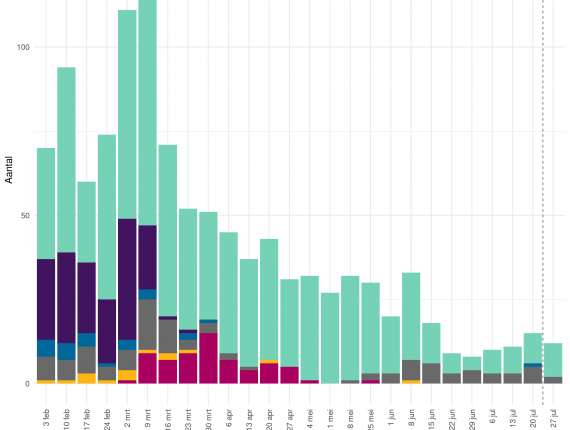
2,588 new COVID-19 infections were reported over the past week. That is 1,259 more confirmed cases reported than the week before that, when 1,329 new COVID-19 infections were reported.
There are major regional differences in the number of confirmed cases (see figure 1). The province of South Holland in particular showed an increase in the number of confirmed cases, followed by North Holland and North Brabant. (see epidemiological report - only in Dutch)
Percentage of positive tests doubled in the past week, fewer people tested
Between 27 July and 2 August, the number of people tested at the GGD test sites was just over 100,000*, a decrease of about 10,000 people tested compared to the previous week. The test results are now known for just under 100,000 people. The percentage of positive tests in the GGD test lanes more than doubled, rising from 1.1% in the week of 20 July to 2.3% in the week of 27 July. The percentage of positive tests was higher than last week in almost all regions; the highest percentage (3%-7%) was seen in the GGD regions of Rotterdam-Rijnmond, Amsterdam, West-Brabant, and Haaglanden. These are also the regions where most of the known clusters are located, and where a relatively large number of people were tested because they were a close contact of a person with a confirmed COVID-19 infection.
One-quarter of the people who tested positive are in the age group of 20-29 years old. However, half of the people who tested positive and have been hospitalised are 60 years or older.
Hospital admissions (current or previous) due to COVID-19 were reported during the past week for 44 patients. That is 21 more than last week.
*Source: GGD-GHOR
Reproduction number R
The reproduction number (R) indicates how many other people are infected on average by one person who has the novel coronavirus. The reproduction number is 1.20. This means that 100 people who are infected with the novel coronavirus will collectively infect another 120 people. Although the number is lower than the 1.40 reported last week, the bandwidth has hardly changed. The confidence interval is still entirely above 1.
Number of infection clusters rises to 242
There are currently 242 known active COVID-19 clusters in the Netherlands. This represents an increase of 109 clusters of three or more related infections compared to the previous week. Over the past week, the average size of these clusters was 5.7 people (range: 3-37). The GGD is using source and contract tracing to try to identify where each infected person contracted the novel coronavirus. The source of most infections is still within the home; this is the case in 52.8% of all clusters. Most of the other infections are the result of contact with other family members, friends, at parties, in the workplace or other leisure activities such as cafés, restaurants or sports clubs. In 70% of the infection clusters, the source has not yet been registered; this figure is higher than last week due to delays in registration as a result of the large number of reports in a number of regions.
Source and contact tracing
The results of source and contact tracing are now available up to week 30 (13 July to 26 July). Among the close contacts identified in that 14-day monitoring period, 344 COVID-19 infections were identified (8.4% of all close contacts). The percentage of contacts that were infected varied between household members and other close contacts. In the monitoring period from 13 July to 26 July, 13.0% of the household members turned out to be infected with the novel coronavirus. 5.6% of the other close contacts were infected.
Other viruses active in the Netherlands
Samples are being taken from a sample set of people with flu-like symptoms or other acute respiratory symptoms who go to a GP. These samples are taken by GPs from practices that are testing stations for the primary care database maintained by the Netherlands Institute for Health Services Research (NIVEL). RIVM then tests those samples for five viruses: the influenza virus, the RS virus, the rhinovirus, the enterovirus, and SARS-CoV-2 (the novel coronavirus). From late January to mid-March, the influenza virus was frequently detected. From March to early May, a positive test for viruses at the testing stations primarily detected the novel coronavirus. From 11 May to 27 July, the rhinovirus was the virus found most frequently in the samples. (see figure 2). It is possible that people who tested negative may still have other viruses, since the tests only cover a limited number of viruses. As of this week, this report will be included in the epidemiological report.
Infection and travel history
Since 1 July, the international travel history of people who tested positive for COVID-19 has been requested. In the past week, 218 persons who tested positive for COVID-19 had been in a different country 14 days before the start of the confirmed infection. The highest number of people who tested positive and had a travel history had been to Spain: 23%. This is followed by travellers to France (16%), Belgium (15%) and Germany (9%). This does not mean that all these people contracted the infection in a different country.
To prevent the virus from continuing to spread, it is important for people to comply with the measures: Keep your distance, and stay home and get tested if you have symptoms. Wash your hands, sneeze and cough into your elbow, and use paper tissues.
Rotterdam
In the media, the impression has risen that RIVM issued a negative travel advice for Rotterdam. However, that is not the case. We are asking people to avoid busy places. This applies not only to the city of Rotterdam but also to other busy cities and places.

